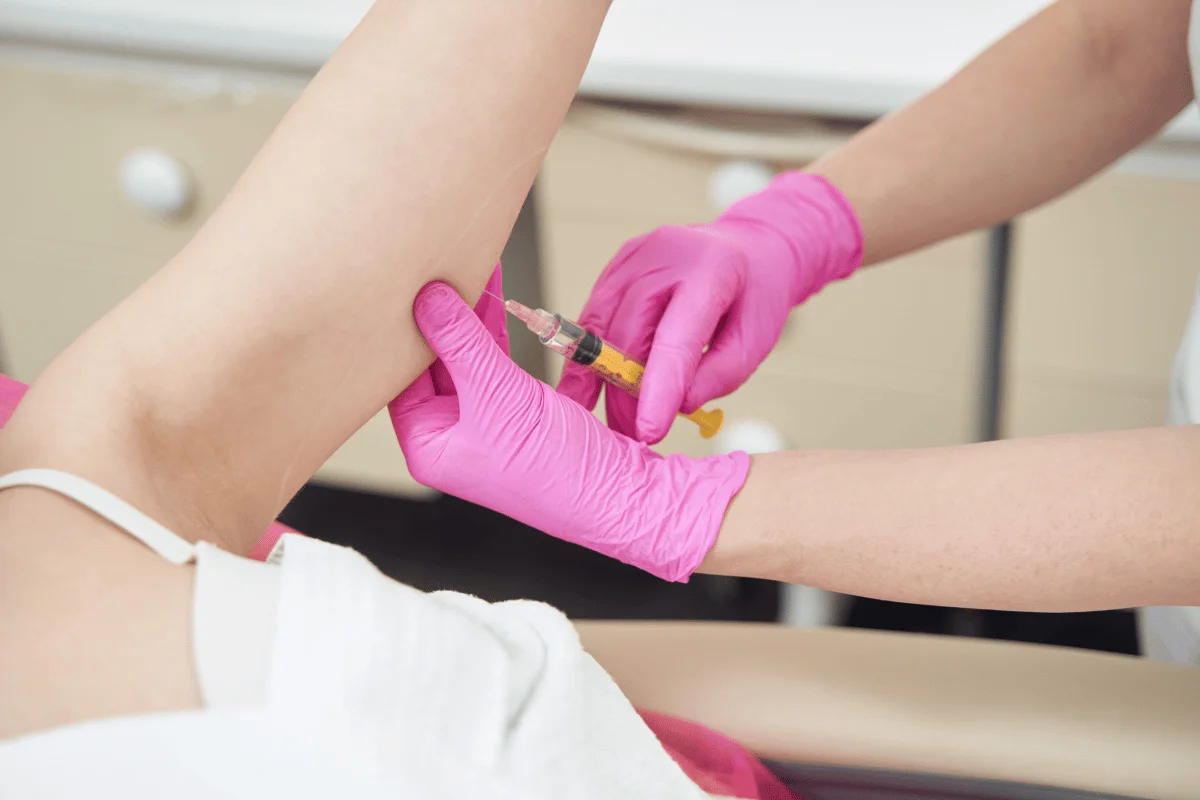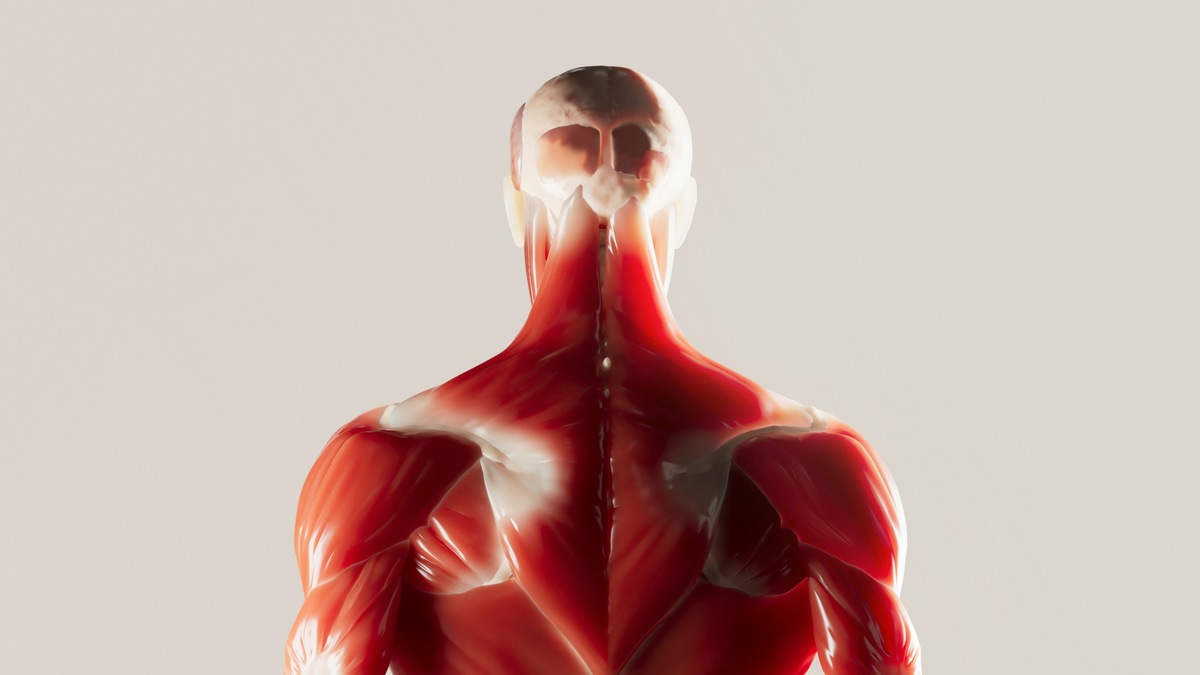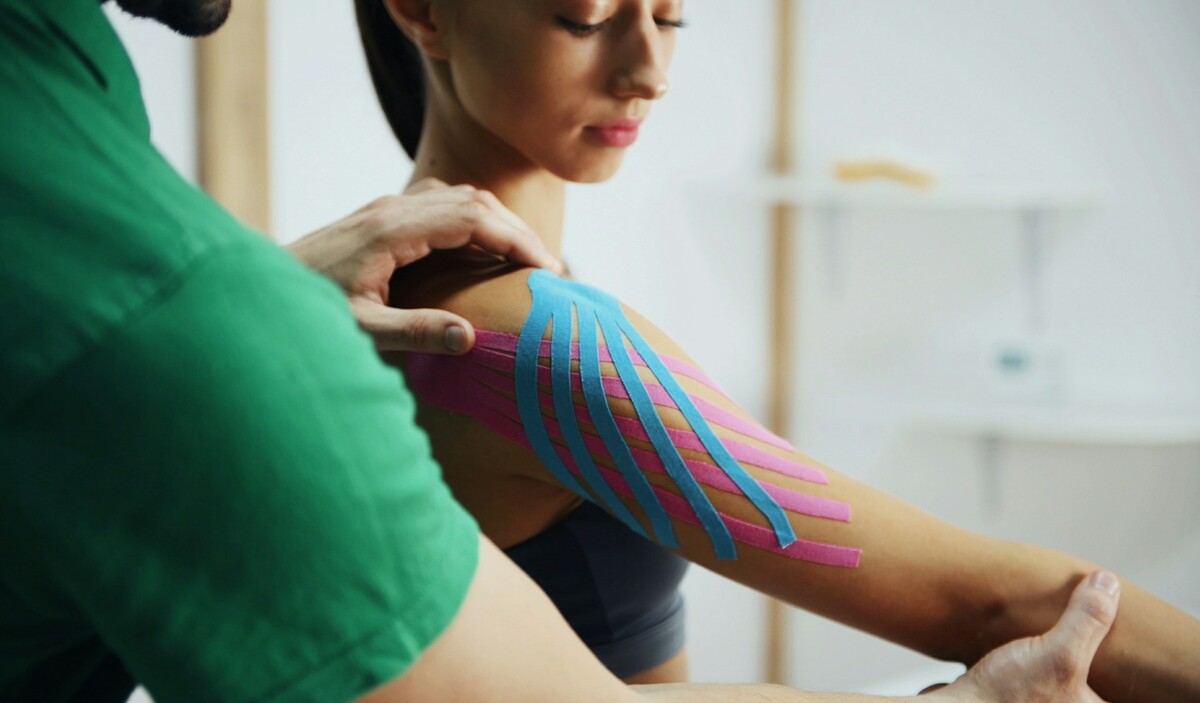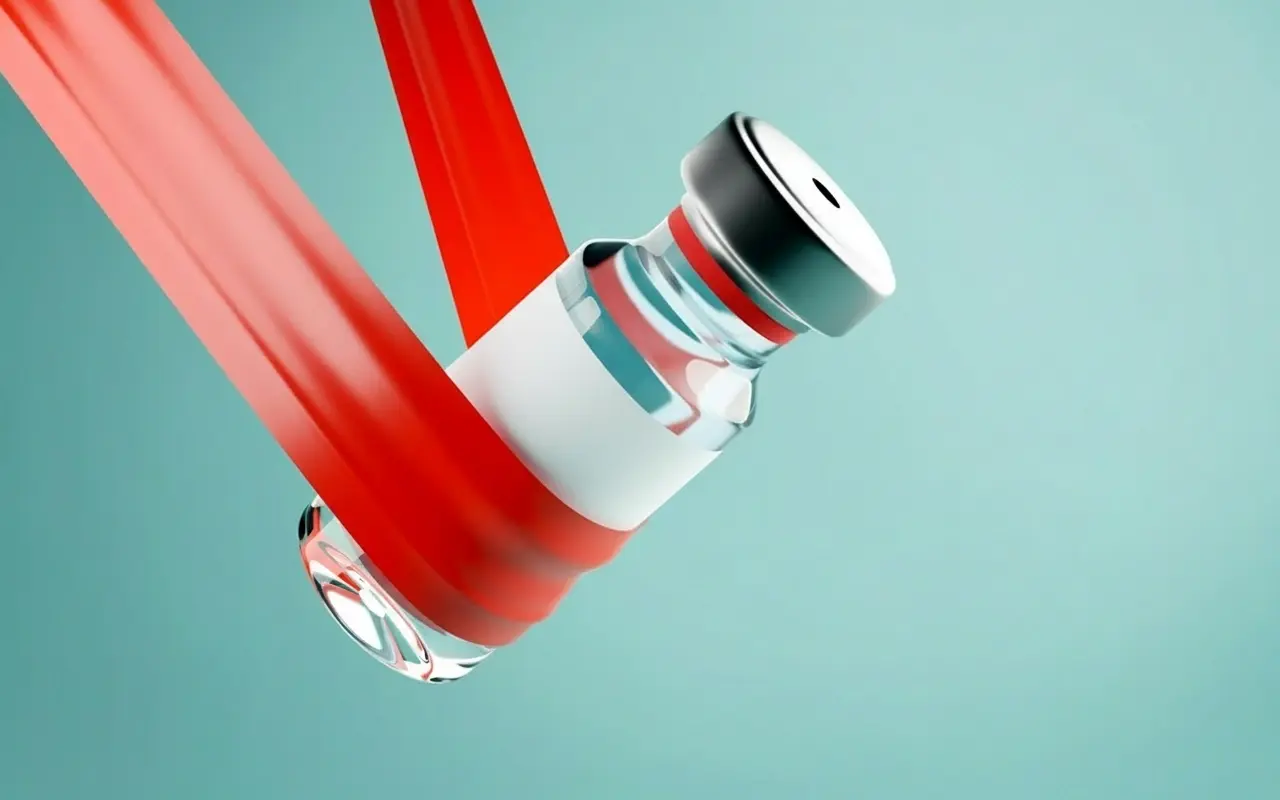[Disclaimer: This article is for informational purposes only and does not constitute medical advice. Always consult with a qualified healthcare provider before starting any peptide therapy. The information provided about injection techniques should only be implemented under proper medical supervision.]
Did you know that choosing the right injection spot for peptides can make or break your results?
Even experienced users sometimes get this wrong, leaving them with subpar results from their expensive peptides.
The good news?
Mastering peptide injection sites is actually pretty straightforward once you know the basics.
In this guide, we’ll cut through the confusion and show you exactly where to inject peptides for optimal absorption and comfort.
No complicated medical jargon, just practical know-how that’ll help you get the most out of your peptide protocol.
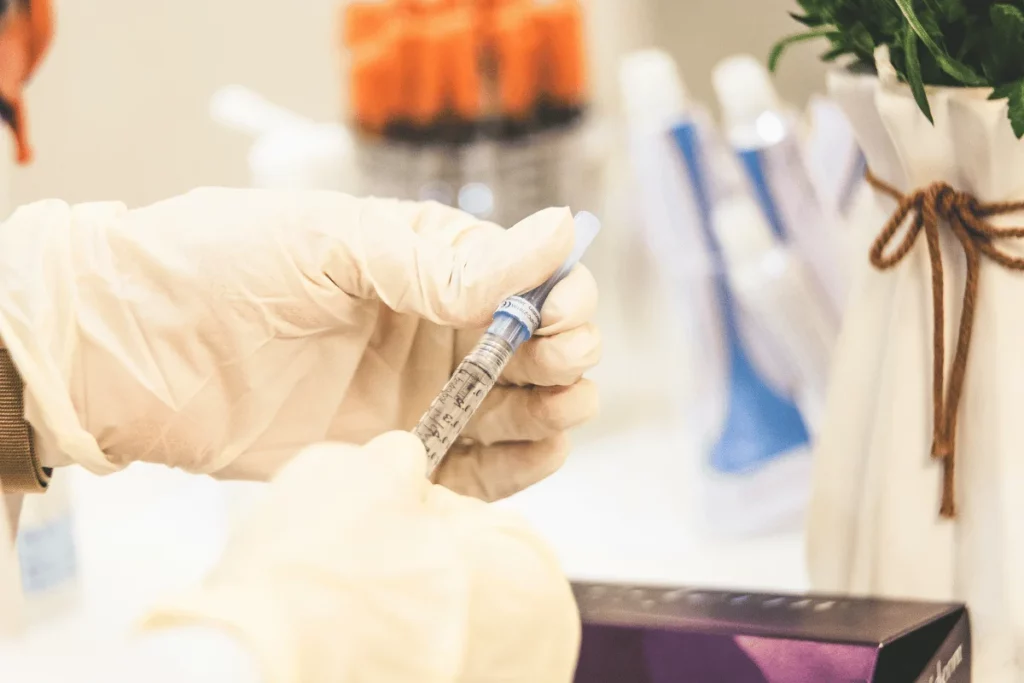
What Are Peptide Injections?
Peptide injections are a way to deliver chains of amino acids (peptides) directly into the body to help with various health goals.
If we go back a bit, peptides are smaller versions of proteins (2-50 amino acid chains) that can target specific bodily functions, from muscle growth to skin health, even treating obesity and type-2 diabetes.
These injections typically come as lyophilized (freeze-dried) powders that must be mixed with sterile liquids to create an injectable solution.
The primary routes of administration are:
- Subcutaneous (under the skin)
- Intramuscular (into the muscle)
- Intravenous (into the veins)
All these methods help your body absorb peptides more effectively than oral supplements since stomach acids often break down peptides before they can reach your bloodstream.
Subcutaneous vs. Intramuscular vs. Intravenous Peptide Injections
Let’s break down the three main types of peptide injections:
- Subcutaneous Injection: This involves injecting medication into the fatty tissue just under the skin using short, thin needles about ¼ to ½ inch long. Subcutaneous injections allow for steady absorption into the bloodstream over time. Peptides requiring systemic effects (effects occurring in sites different from the site of contact) or slower absorption rates are given via the subcutaneous route. These injections are:
- Usually done at a 45° angle
- Most common method for peptide therapy
- Generally less painful
- Ideal for daily use
- Intramuscular Injection: Here, the needle pierces deep through skin and fat to deposit medication directly into muscle tissue (at a 90° angle). Intramuscular injections deliver drugs rapidly using longer needles of 1-1 ½ inches. Peptides intended for quick absorption or targeting injury sites need intramuscular delivery. It may cause more discomfort/pain than the subcutaneous method.
- Intravenous Injection: This method injects medication directly into a vein and is the fastest way to deliver drugs throughout the body. However, intravenous injection requires medical training and supervision due to its complexity.
Subcutaneous and intramuscular are the most common methods of peptide injection. Intravenous is rarely used for peptide therapy and is usually reserved for clinical settings only.
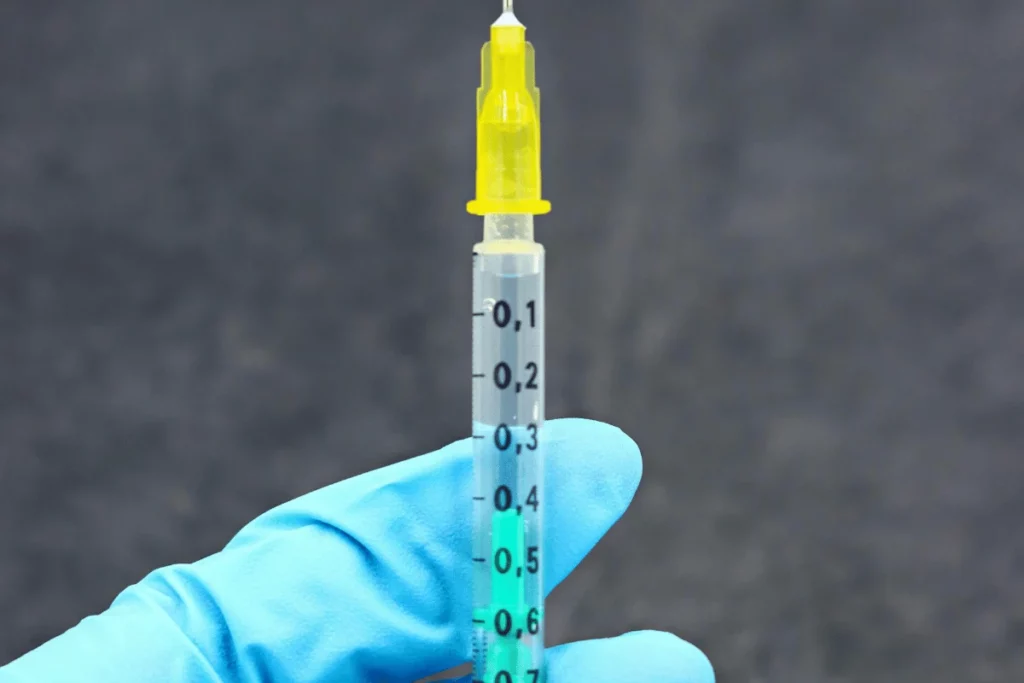
Where to Inject Peptides
The best injection sites depend on your chosen method.
Here’s a detailed breakdown:
Best Sites for Under-the-Skin (Subcutaneous) Injections
Your abdomen is usually the best place to start with peptide injections. It’s easy to reach, has plenty of fatty tissue, and absorbs peptides well.
Just make sure to stay at least 2 inches away from your belly button. Many people find this spot the least painful and easiest to work with.
The upper thigh is another great option, especially if you’re new to self-injection.
You can easily sit down while injecting, and the large area lets you rotate injection spots effectively.
Plus, this area tends to be less sensitive than the abdomen.
Some other common injection sites include:
- Upper arm (around the back of your arm where there’s more fat)
- Lower back area (though you might need help reaching it)
- Outer hip region (if you have enough fatty tissue there)
Best Sites for Into-the-Muscle (Intramuscular) Injections
Your upper arm muscle, specifically the deltoid, works well for smaller amounts of peptides.
It’s the same spot where you usually get flu shots. The muscle absorbs peptides quickly, and you can easily reach it yourself.
For larger volumes of peptides, try your outer thigh muscle (doctors call it the vastus lateralis).
You can sit comfortably while injecting, and the large muscle area makes it easier to rotate injection spots.
Many people find this spot quite comfortable for regular injections.
Also, the buttocks area offers the largest injection site and often causes the least pain.
However, you’ll probably need someone to help you inject here.
This spot works especially well for larger amounts of peptides or if other injection sites are sore from regular use.
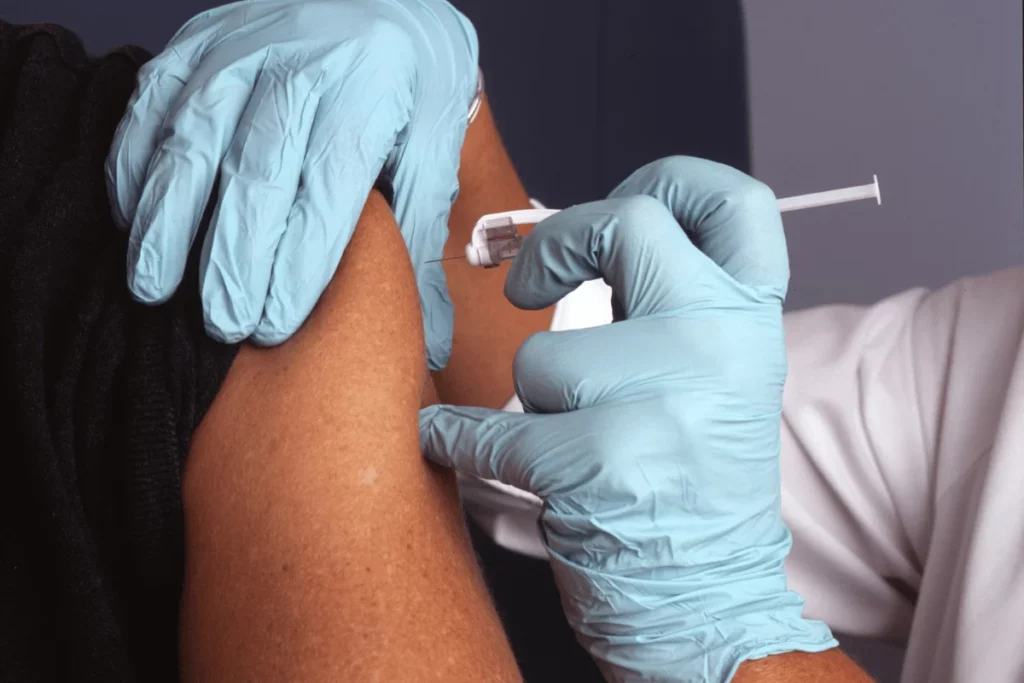
How to Choose the Right Site for Injecting Peptides
Let’s walk through everything you need to consider when choosing where to inject your peptides:
Match Your Peptide to the Right Method
Check your peptide’s instructions or ask your healthcare provider about the best method for your specific peptide.
Key things to check:
- What type of injection your peptide needs
- How much you need to inject each time
- Any specific sites that work best for your peptide (or for a specific use case)
Not all peptides work the same way in your body.
Some peptides need to be injected under your skin (GHK-Cu, for example), while others work better when injected into the muscle (BPC-157, CJC-1295, Ipamorelin, etc.)
Pick Spots You Can Easily Reach
Think about your comfort and ability to reach different injection spots safely.
You’ll want to choose places you can easily see and reach without straining.
Some spots to consider:
- Your stomach area – usually easiest to reach
- Front of your thighs – good when sitting down
- Back of your arm – might need help from someone else
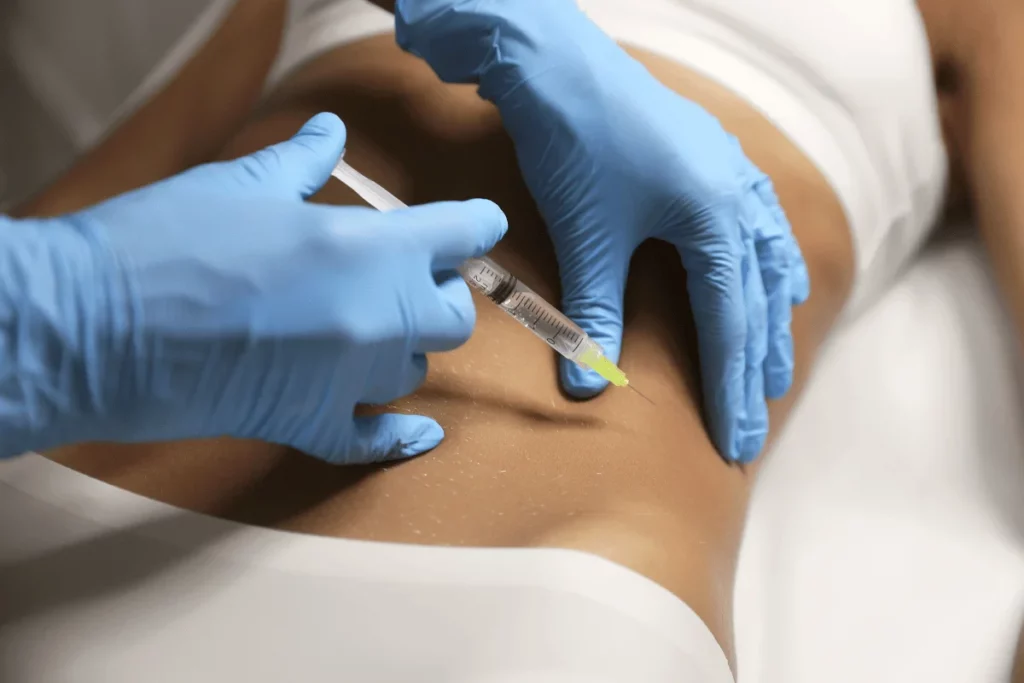
Check for Enough Tissue
Before you choose a spot, make sure there’s enough tissue there for your type of injection:
- For under-the-skin injections, you need enough fatty tissue to pinch.
- For muscle injections, you need a good amount of muscle mass.
Find spots where you can:
- Easily pinch an inch of skin for under-skin injections
- Feel firm muscle for muscle injections
Avoid areas where you can feel bones close to the surface.
Keep Track and Rotate Your Spots
Using the same spot too often can cause soreness and affect how well your body absorbs the peptide.
Create a simple rotation plan to give each injection site time to recover.
You might want to:
- Mark your injection spots on a body diagram
- Keep a log of which spots you’ve used
- Wait at least a week before using the same spot again
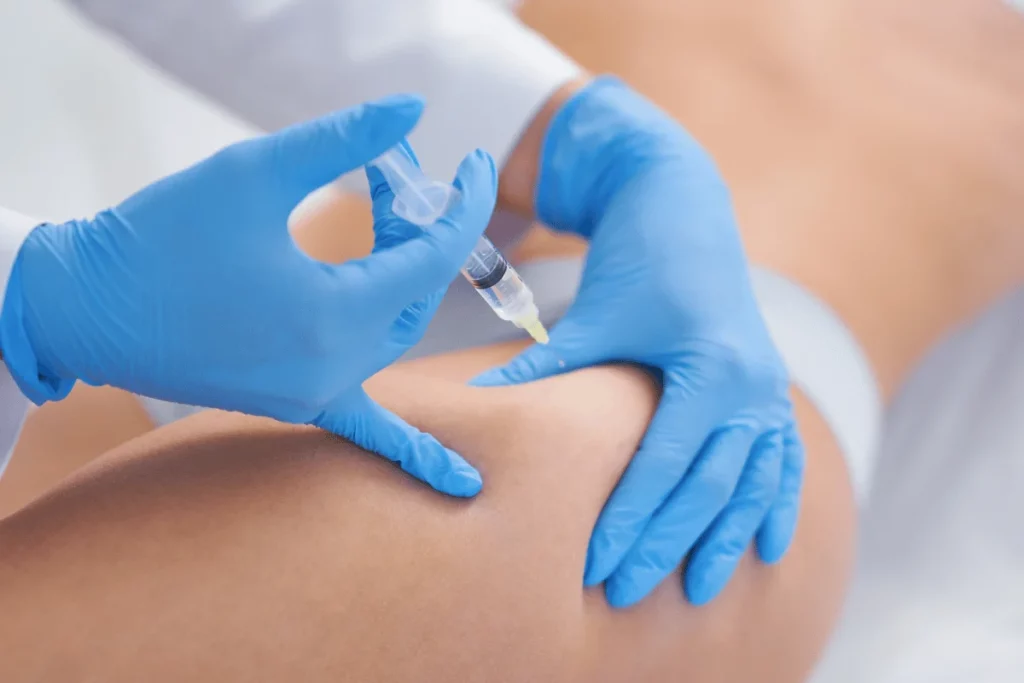
How to Inject Peptides
Before injecting peptides, you’ll need to prepare them properly.
Let us walk you through the entire process, from mixing your peptides to safely disposing of the needle:
1. Preparing Your Peptides (Reconstitution)
When you receive your peptides, they will typically come in a powder (lyophilized form).
You’ll need to mix this powder with a special type of water to make it injectable.
What you’ll need:
- Your peptide vial (the powder)
- Bacteriostatic water (BAC) or sterile water
- Alcohol wipes
- A mixing syringe
- A peptide dosage calculator
Step by step:
- Take the caps off both vials and clean the rubber tops with alcohol wipes.
- Figure out how much water you need (use the guide that came with your peptides or a peptide calculator app).
- Draw up the right amount of water in your syringe.
- Slowly add the water to your peptide vial by letting it drip down the side.
- Gently swirl the vial to mix – don’t shake it, as peptides are fragile.
If you’re more of a visual learner, check out this helpful video walkthrough of the reconstitution process.
2. Understanding Your Syringe
Different syringes can make measuring tricky.
Most people use insulin syringes, which come in two types:
- U-100 syringes (most common)
- U-40 syringes (less common)
Let’s say you have a 5mg vial of BPC-157 and want a 250mcg dose.
Here’s how to calculate it:
- Convert 5mg to micrograms (5mg = 5000mcg)
- If you add 2mL of water, each 0.1mL will contain 250mcg
- On a U-100 insulin syringe, this means pulling to the 10-unit mark
Leading health optimization expert “Ben Greenfield” backs this approach to measuring and calculating doses.
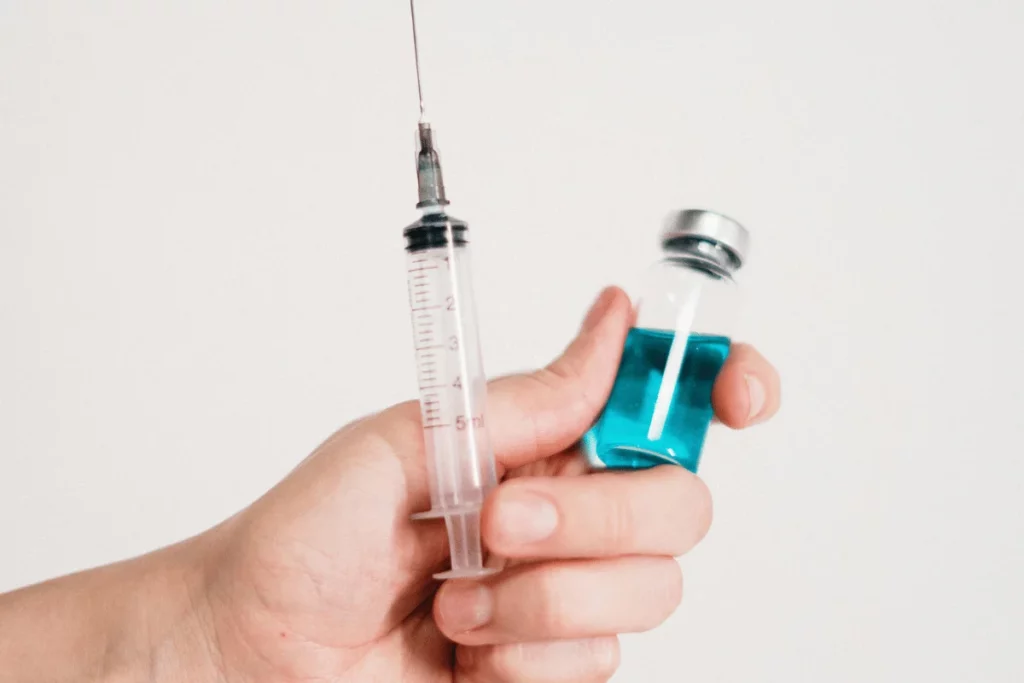
3. Getting Ready for Injection
You’ll need:
- Your mixed peptide
- A fresh insulin syringe (28-31 gauge, ½ inch for under-skin) or a larger needle (22-25 gauge for muscle)
- Alcohol wipes
- Clean gloves if you want them
- A sharps container
Before injecting:
- Let your peptide warm up to room temperature
- Wash your hands thoroughly
- Clean the injection spot with an alcohol wipe
- Draw up your dose carefully
- Check for air bubbles and tap them out
4. Giving Yourself the Injection
For under-the-skin (subcutaneous) injection:
- Pinch an inch of skin at your chosen spot.
- Insert the needle at a 45-degree angle if you have less fat or 90 degrees if you can pinch more skin.
- Push the plunger slowly and steadily
- Pull the needle out smoothly
Want to see exactly how it’s done? Watch this detailed subcutaneous injection tutorial.
For muscle (intramuscular) injection:
- Find a meaty spot with plenty of muscle
- Insert the needle straight in (90 degrees)
- Push the plunger more slowly than with under-skin shots
- Remove carefully – this one might pinch a bit more
Not sure about the technique? Here’s a clear video demonstration of intramuscular injection.
5. After Your Injection
Here are a few important steps to finish up:
- Gently massage the area for about 30 seconds to help absorption
- Don’t recap the needle – this can cause accidental sticks
- Drop the used needle right into your sharps container
- Store your mixed peptides in the fridge
Never throw used needles in the regular trash. Take your full sharps container to:
- A local medical waste facility
- A pharmacy that accepts sharps
- An FDA-approved mail-back program
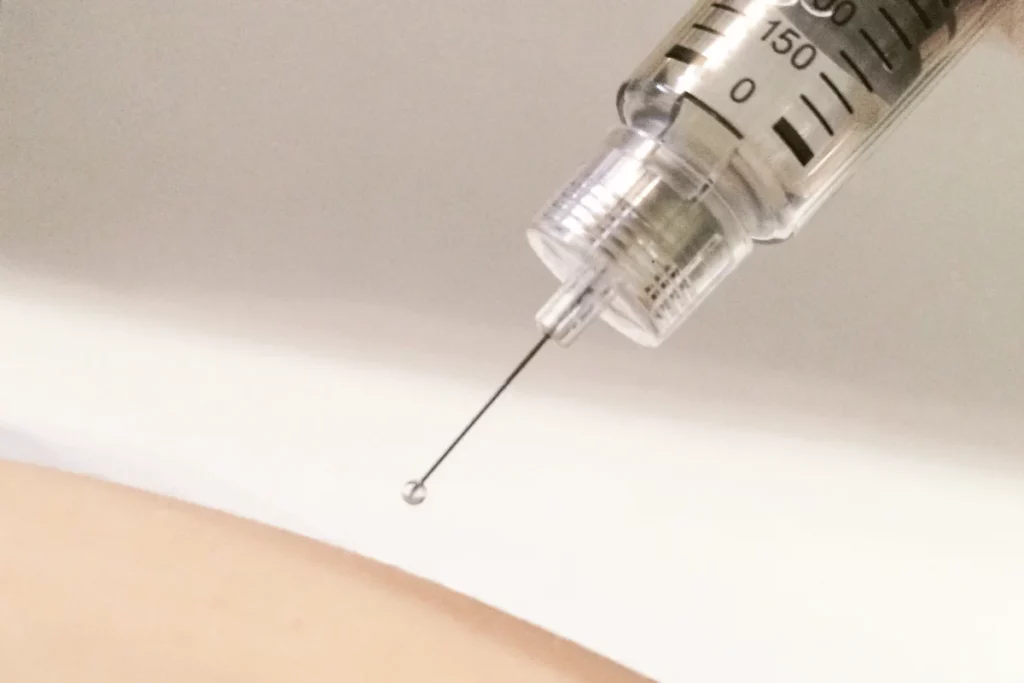
Where to Get Peptide Injections
Knowing where and how to get peptides through legitimate channels is crucial for your safety.
Here are your best options:
- Medical Clinics: The safest environment for FDA-approved peptide therapy, with doctors supervising your treatment and providing professional guidance throughout your journey. You’ll receive comprehensive medical oversight and can address any concerns immediately with trained professionals.
- Wellness Centers: These facilities offer peptide treatments in a spa-like setting with specially trained staff. They typically offer complete programs that include regular progress monitoring and adjustments to the treatment plan as needed.
- Home Administration: You can administer peptides at home with a doctor’s prescription and proper training. Most people choose this way for biohacking through peptides! If you choose this route, ensure you get thorough instruction from experts, understand all safety protocols, and maintain regular check-ups to monitor your progress.
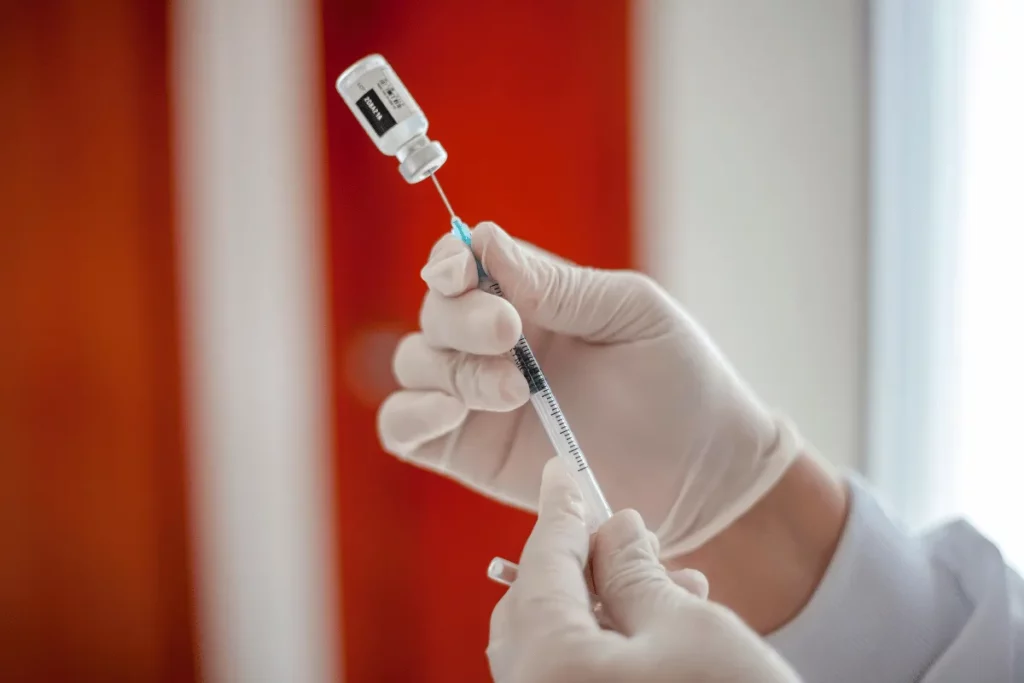
Are Peptide Injections Dangerous?
When administered correctly under medical guidance, peptide injections are considered extremely safe with virtually no side effects.
Still, unsupervised misuse does pose health risks:
- Contamination and poor injection hygiene can cause infections.
- Improper dosing or injection locations could lead to complications like:
- Injection site redness
- Minor bruising
- Temporary soreness
- Mild swelling
Consult a doctor before using injectable peptides. Carefully vet product quality and purchase only from licensed sources, such as Biolongevity Labs.
Seek immediate medical help if adverse reactions occur.

Frequently Asked Questions (FAQs)
Let’s address some common questions about peptide injections:
How Often Do You Inject Peptides?
How often you inject peptides depends on the type, purpose, and prescribed protocol.
The frequency can range from multiple daily shots (for thymosin beta 4 or TB-500 dosage) to once-daily administration (CJC-1295) or one weekly injection (Semaglutide 2.4 mg for weight management).
Follow medical advice and stick to timing guidelines for optimal results.
How Long Do Peptides Remain Effective After Being Injected?
Effectiveness varies by:
- Peptide type
- Injection method
- Individual metabolism
- Storage conditions
Most peptides have very short half-lives of 2-30 minutes in circulation after injection. However, some peptides have a very long half-life.
For example, CJC-1295 remains active in your system for 5.8-8.1 days. In fact, after multiple doses, they work for up to 28 days!
What Should I Do if I Miss a Dose of My Peptide Injection?
If you miss a scheduled injection, do not double the dose to compensate.
Simply administer the missed quantity as soon as possible unless it is more than 4 days (96 hours) late. If it is more than 4 days late, skip the missed dose.
Resume your normal timing protocol for subsequent doses.
Conclusion
Safe peptide injection comes down to choosing the right spot, maintaining good hygiene, and following the proper technique.
Your success with peptides depends largely on how well you handle these basics.
Remember to start slow and always prioritize safety.
Here at All About Peptides, we help health enthusiasts like you navigate the world of therapeutic peptides.
Want to learn more about optimizing your health through peptides? Join our free newsletter and connect with hundreds of biohackers already achieving peak performance.
Come be part of our community – we’re excited to share our latest peptide insights with you!


